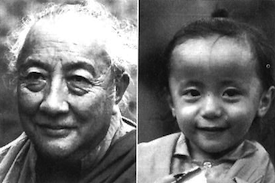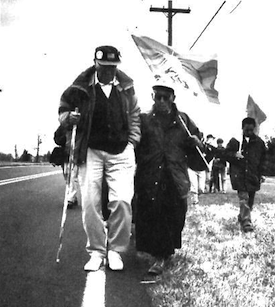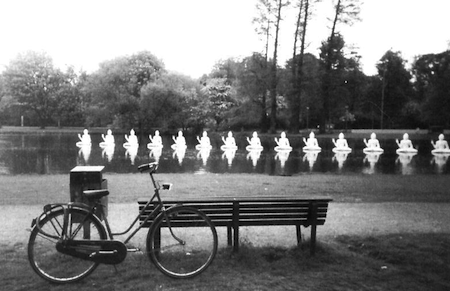BUDDHA’S BETHLEHEM
Nepalese Prime Minister Sher Bahadur Deuba recently announced that an international team of archaeologists has uncovered the birthplace of Prince Siddhartha Gautama, the historical Buddha. The site was buried under the Mayadevi temple in Lumbini, 200 miles southwest of Kathmandu. Archaeologists spent two years excavating the three-square-mile site which includes a platform of bricks with a large stone on it as well as the pond where, according to legend, Mayadevi bathed before giving birth to the historical Buddha 2,500 years ago. The platform itself dates from the era of Ashoka, who ruled the subcontinent (ca. 273—232 B.C.E.) and is said to have had a stone placed on bricks at the birthplace as well as a pillar that still stands. Deuba stated that “the discovery proves that Lord Buddha was born at this sacred place.” According to government officials, a group called Lumbini Development Trust will develop the site into a tourist attraction.
LIFE AFTER DEATH

On December 29, 1995, Trulshik Rinpoche performed the hair-cutting ceremony at Maratika Cave in Nepal for the reincarnation of H. H. Dilgo Khyentse Rinpoche. The boy, who was given the name Ugyen Tenzin Jigme Lhundrup, was born on Padmasambhava’s birthday, the tenth day of the sixth month of the bird year (June 30, 1993). H. H. the Dalai Lama has confirmed the reincarnation. The boy’s enthronement will take place at Shechen Monastery in Nepal after two or three years. Dilgo Khyentse Rinpoche was considered one of the leading masters of the pith-instructions of the Dzogchen teachings of Tibetan Buddhism. He died in 1991 at the age of 81, and was the reincarnation of Jamyang Khyentse the Great, one of the founders of the non-sectarian, or Rime, movement that arose in nineteenth-century Tibet.
DOWN BY LAW
The Federal Bureau of Prisons has refused to allow the newsletter of the Engaged Zen Foundation, The Gateway Journal, to be sent to a California inmate because “the material depicts, describes or encourages activities which may lead to use of physical violence or group disturbance . . . The publication constitutes a threat to the security, good order, and discipline of the institution.”
The most recent issue of the journal contained the second installation of Zen Karmics (see the first installation in the Winter 1995 Tricycle), which gives meditation instruction and an article about the first Jukai ceremony (a Zen ceremony in which a practitioner formally becomes a Buddhist) performed at Sing Sing Correctional Facility in New York State. The Engaged Zen Foundation is currently considering legal action to defend the inmates’ First Amendment rights.
ON THE (SILK) ROAD
In its April 1996 issue, National Geographic published a piece about 363 caves along China’s Silk Road in central Xinjiang. The caves are filled with Buddhist paintings dating back to 400—700 C.E. The paintings were apparently commissioned by laypeople of indeterminate origins (their ancient cities have yet to be excavated).
The painters ground such minerals as malachite for green, iron oxide for red, and lapis for blue. Thieves have stolen some of the paintings by cutting around them and lifting away the mud and straw plaster on which they are painted, but most remain intact and remarkably well preserved with their colors still vivid.
The caves themselves were carved into the sandstone cliffs of the Tian Shan range as early as the fifth century A.D., to be used as shrines and places of worship for followers of the new religion spread by Indian monks who traveled with traders on the Silk Road.
McMEDITATION

Our Northwestern correspondent Stuart Torgenson recently came across this cultural icon in seated repose in Stanwood, Washington. Says Stuart, “He sat in this position for two weeks without a stretch break!”
DC TO NY: WALKING THE PATH OF TIBETAN LIBERATION

From March 10 to April 25, supporters of Tibetan independence marched 300 miles from the embassy of the People’s Republic of China in Washington, D.C., to the United Nations in New York. Professor Thubten Jigme Norbu, elder brother of the Dalai Lama, led the group into New York, where they were honored at a celebration sponsored by the Office of Tibet. Also marching was Palden Gyatso, who recently testified before Congress about the torture he underwent in a Chinese prison. The march was sponsored by the International Tibet Independence Movement, the U.S. Tibet Committee, The Tibetan Women’s Association, and Students for a Free Tibet.
Organizers of the march stated that their goals include the following: demonstrating absolute support for Tibet’s independence, petitioning the U.N. to grant observer status to the Tibetan Government-in-Exile, and protesting China’s choice for the Panchen Lama. The Tibetan’s choice, at age 7, is considered to be the world’s youngest prisoner of conscience.
FOR THE RECORD
On April 15 the International Campaign for Tibet released their report “A Season to Purge: Religious Repression in Tibet.” The report analyzes the structures and methods of Chinese government and party controls over Tibet’s monasteries, which are supposedly protected as religious institutions under the Chinese constitution. In a phone interview, International Campaign for Tibet’s director John Ackerley said, “In general, Buddhism is not a very politically active religion. But in Tibet it has taken on an incredible political significance, which is the principal reason it is being repressed there. Today Tibetan Buddhism has become a very unique form of liberation philosophy, and is playing a political role which is not being done anywhere else in the world. As a result it is being punished.”
The report details how the Chinese government is currently engaged in an extensive campaign to limit the spread and growth of Tibetan Buddhism. It also reveals how the Chinese government misled the United Nations Special Rapporteur on religious intolerance during his two-day stay in Lhasa. Chinese officials claimed that there are no restrictions keeping Party members from practicing Tibetan Buddhism or prohibiting Tibetans under the age of 18 from joining monasteries. Both statements are gross misrepresentations of China’s actual practices in Tibet. There is also a detailed analysis of the controversy surrounding the reincarnation of the Panchen Lama.
Another report, titled “Cutting off the Serpent’s Head,” was released in March by the London-based Tibet Information Network (TIA). It accused Beijing of restricting freedom of religion and of widespread torture of Tibetans detained for demanding independence. “Popular dissent and disaffection has increased in Tibet during the 1990s, despite the imposition of draconian security measures intended to defeat it,” the report said. According to the TIA, the number of detentions rose after the United States and other Western nations lowered the importance of human rights in their relations with Beijing in 1994.
GREEK TO ME
In Thessaloniki, Greece, on March 26-27, Mrs. Hara Kalomiri was tried for and convicted of “building a place for Buddhist worship.” Mrs. Kalomiri, founder and chair of the Karma Rigdrol Ling society, which built a retreat center on the peninsula of Chaldiki, was sentenced to three months in prison. A senior student of and translator for Tsultrim Khenpo Rinpoche, she began organizing Shambhala training in Greece in 1993.
The law that Mrs. Kalomiri was found guilty of breaking dates back to the fascist dictator Metaxas, who passed it in 1938, and is designed to keep nonorthodox religions off Greek soil. The European High Court in Strasbourg has informed the Greek government that the law is in violation of the European Human Rights Convention of Rome, and that it should be repealed. So far, Greece has not responded.
WAX BUDDHAS

14 wax “Peace Buddhas” by the Patchwork Art Collective, on display in Vondel Park in Amsterdam, are designed to melt over time, providing a concrete lesson in impermanence.
TRIAL BY ERROR
A lawsuit filed in the California Superior Court in Santa Cruz, California, alleging sexual abuse by Sogyal Rinpoche (head of the Rigpa Fellowship and The Spiritual Care for Living and Dying, which were also named in the suit), has reportedly been settled out of court. Santa Cruz Municipal Court files indicate that a dismissal was filed for the entire action on February 22, 1996. Rigpa spokespoerson Sandra Pawula said, “It was resolved through mediation and I can’t say anything beyond that,” citing that the details of the resolution are confidential.
The suit, which was filed under the fictitious name “Janice Doe” in November 1994, claims that “Sogyal Rinpoche has used his position as an interpreter of Tibetan Buddhism to take sexual and other advantage of female students over a period of many years, and has caused extreme injuries to many students, including plaintiff.” The suit asked for punitive damages in the sum of $10 million. Although no amount has been disclosed, sources say that a monetary settlement has been reached, including an agreement under which the plaintiff cannot discuss the case.
RUNNING STRONG
A 27-year-old Tibetan nun, Phuntsok Nyidron, was the recipient of the 1995 Reebok Human Rights Award. The award, which was presented by Richard Gere, was accepted on Nyidron’s behalf by Kalsang Jamyang in New York last December. Nyidron is in prison in Tibet for having openly celebrated the announcement of the Dalai Lama’s Nobel Peace Prize in 1989. She and five other nuns staged a demonstration in Lhasa on October 14, 1989, and were arrested by Chinese police. Amnesty International has reported that “for that simple act, all six nuns were interrogated, tortured, tried, and imprisoned.” Nyidron was initially sentenced to nine years in prison, but her sentence was extended to 17 years in 1993 as a result of her composing and recording songs for independence. Her sentence ends in 2006 and is the longest known sentence for a female political prisoner in Tibet.
MIXED SIGNALS
The Yongquan Temple has become the first Buddhist monastery in China to buy television advertising time, the New China News Agency reported. The monastery beat out other contenders with a bid of $24,000 to win time on the 8 a.m. “Good Morning Fujian” program, on Fujian provincial television. Yongquan temple will use the advertising spot to promote Mount Gushan, a leading tourist spot in Fujian and the site of the monastery. Master Pufa, the temple’s abbot, said the monastery wanted to extend the monks’ greeting to Fujian and its people.
In an April 9 Worker’s Daily editorial, Chinese Communist Party officials in Fujian were blasted for putting aside their revolutionary zeal and paying their respects to Buddha at local temples. They were accused of abusing their positions and angering “the people” by using official cars to take part in superstitious practices. The editorial published the registration numbers of official cars that were parked near the temples and said, “This is a kind of corrupt phenomenon. This is an expression of loss of faith in Marxism.”
THE WHEEL
New: Charlotte Joko Beck, a dharma heir of the late Maezumi Roshi, recently established the Ordinary Mind Zen School, which has “no affiliation with other Zen groups or religious denominations.” In Albuquerque, New Mexico, the recently formed Hidden Mountain Zen Center will be installing its abbot, Jitsudo Ancheta, this July. Old: The first traditional Japanesep-style Rinzai Zen monastery in America, Dai Bosatsu Zendo, founded by Eido ShiShimano Roshi, will celebrate its 20th anniversary on July 4. Insight Meditation Society in Barre, MA, will also be celebrating its 20th anniversary on August 3. Rochester Zen Center, founded by Roshi Philip Kapleau (author of Three Pillars of Zen [1965], the first book to provide meditation instruction for Westerners) will celebrate its 30th anniversary by holding a conference on “American Buddhism Today” in June. For the first time, the Dalai Lama will give teachings to an exclusively Chinese group, the Chinese Buddhist Community in Los Angeles. For more information, point your Web browser at: http//emma.manymedia.com/tibet/DalaiLama.html. John Lee Hooker, The Beastie Boys, Philip Glass, Smashing Pumpkins, Sonic Youth, etc. will perform at the Tibetan Freedom Concert, June 15-16 in San Francisco. The Houston Grand Opera will premiere Ricky Ian Gordon and Jean-Claude van Itallie’s Tibetan Book of the Dead, a liberation through hearing on May 31; it will be at the American Music Theatre Festival in Philadelphia, June 8-16. Turner Pictures has paid a reported $400,000 for the screenplay Buddha from Brooklyn, the life story of Jetsumma Ahkon Lhamo, the first Western woman to be recognized as a reincarnated lama. Freedom not: China plans to build a “Buddhist City” in central Nanjing. The four-square-mile resort will include a Buddhist statue “designed to be higher than the Statue of Liberty.”
Thank you for subscribing to Tricycle! As a nonprofit, we depend on readers like you to keep Buddhist teachings and practices widely available.